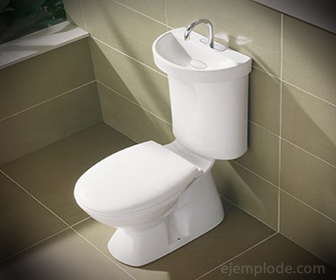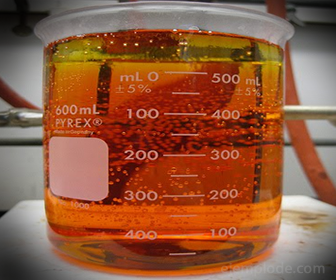Uses of Muriatic Acid
Chemistry / / July 04, 2021
Muriatic acid It is the trade name assigned to Hydrochloric Acid when it is found in aqueous solution. Hydrochloric Acid is the inorganic chemical compound made up of a Hydrogen atom and a Chlorine atom. It is also called Hydrogen Chloride, and it is one of the most important Hydracids, with a powerful acid activity.
Obtaining Muriatic Acid
Hydrogen Chloride is obtained by treating Sodium Chloride NaCl with Sulfuric Acid H2SW4 concentrated in large cast iron retorts. The reaction proceeds in two stages; the first one develops at a relatively low temperature, and produces Hydrogen Chloride HCl and Sodium Bisulfate NaHSO4. Once the first phase is finished, the NaHSO mixture4 and excess NaCl is taken to another retort, where it is heated to red, producing the second reaction:
NaCl + NaHSO4 -> Na2SW4 + HCl
Sodium Chloride + Sodium Bisulfate (heating) -> Sodium Sulfate + Hydrogen Chloride
The HCl gas released in water to prepare commercial Hydrochloric Acid, with a density of 1,196 gr / mL and 38.9% of the compound.
For domestic purposes, it is marketed in aqueous solution with a concentration of 12.5% of Hydrochloric Acid. This is properly Muriatic Acid.
Characteristics and Properties of Muriatic Acid
The Hydrogen chloride It is a colorless gas, with a strong and irritating odor and a sour taste. It can be liquefied at 10 ° C, subjecting it to a pressure of 40 atmospheres. The liquid boils at -84 ° C at ordinary pressure.
The gas is very stable. At 1500 ° C, less than 0.3% is dissociated into its elements. In the gaseous state it smokes in humid air, forming a mist of hydrochloric acid droplets. With Water, it forms an azeotropic or constant boiling-point mixture, with 20.2% HCl, which boils at 110 ° C under an atmosphere of pressure.
HCl Anhydrous liquid does not conduct electric current. It does not react with zinc, but it is enough to add a small amount of water to start the reaction, releasing hydrogen. When Hydrogen Chloride is heated with the most active metals, there is a reaction, producing the Chlorides of the metals and Hydrogen. This method of preparing chlorides is the one used when anhydrous cannot be obtained from an aqueous solution.
Muriatic Acid Applications
After Sulfuric Acid, Hydrochloric is the most used in the industry. It is used as a catalyst to obtain glucose and other products by hydrolysis of starch; in the textile, dye and drug industries; to prepare Chlorides of different metals, and pickling baths to remove oxide slag from iron plates before tinning, galvanizing or enamelling. Glue manufacturers use it to extract the product from animal tissues (hides, hooves and cartilage).
Examples of Muriatic Acid Use
1.- To get Glucose: Muriatic Acid works as a catalyst to obtain glucose, since its ability to dissociate in an aqueous medium allows it to attack starch to hydrolyze it more easily.
2.- To prepare Chlorides of different metals: Salts such as Silver Chloride (AgCl), Iron Chloride (FeCl2), Sodium Chloride (NaCl), Zinc Chloride (ZnCl2) are prepared by the action of the metal immersed in Muriatic Acid, which is an aqueous solution.
3.- For disinfection of toilets: Hygiene in a bathroom is ensured by the brief action of Muriatic Acid, which is responsible for acidifying the medium, mixed with soap, and considerably reducing the bacterial population.

4.- Iron sheet pickling baths: Muriatic Acid helps to eliminate the oxide slag layer that forms on iron plates, to leave them as new, before re-depositing a layer of metal in a galvanizing process, for example.
5.- As an ingredient in Agua Regia: Agua Regia is a mixture of Hydrochloric Acid HCl and Nitric Acid HNO3. Between both acids an attack effect of the most stable metals, such as Gold, is achieved. Thanks to Agua Regia, it is possible to dissolve Gold.

6.- To neutralize spills of Strong Bases: When an accidental spill of a strong base such as Sodium Hydroxide occurs in an industrial plant, it is possible to neutralize this substance by adding Muriatic Acid. After reacting Acid against Hydroxide, there is already a neutral pH and the dangerous situation has ceased.
7.- To prepare standard solutions: Muriatic Acid at various concentrations is useful to prepare standard solutions (solutions of known concentration) to perform volumetric analysis, in which the amount of a known substance in a liquid sample is determined.
8.- To clean laboratory glassware: Muriatic Acid is useful when cleaning laboratory equipment made of glass. These washes ensure the dissolution and total elimination of the chemical substances that have been left behind or stuck in the material. Sometimes Muriatic Acid is heated to better accomplish the purpose.

9.- As a chemical reagent: Muriatic Acid can be used at the laboratory level to generate certain chemical reactions, whether organic or inorganic. The ease of Chloride to detach from Hydrogen helps to accelerate the interaction between reactants.
10.- As supply in Thermoelectric Plants: Muriatic Acid is used to supply it to the trays where the condensation water is cooled (in the cooling towers). The acidity helps to prevent the formation of hardness deposits (Calcium Carbonate CaCO3). This last compound remains dissolved thanks to this supply.


